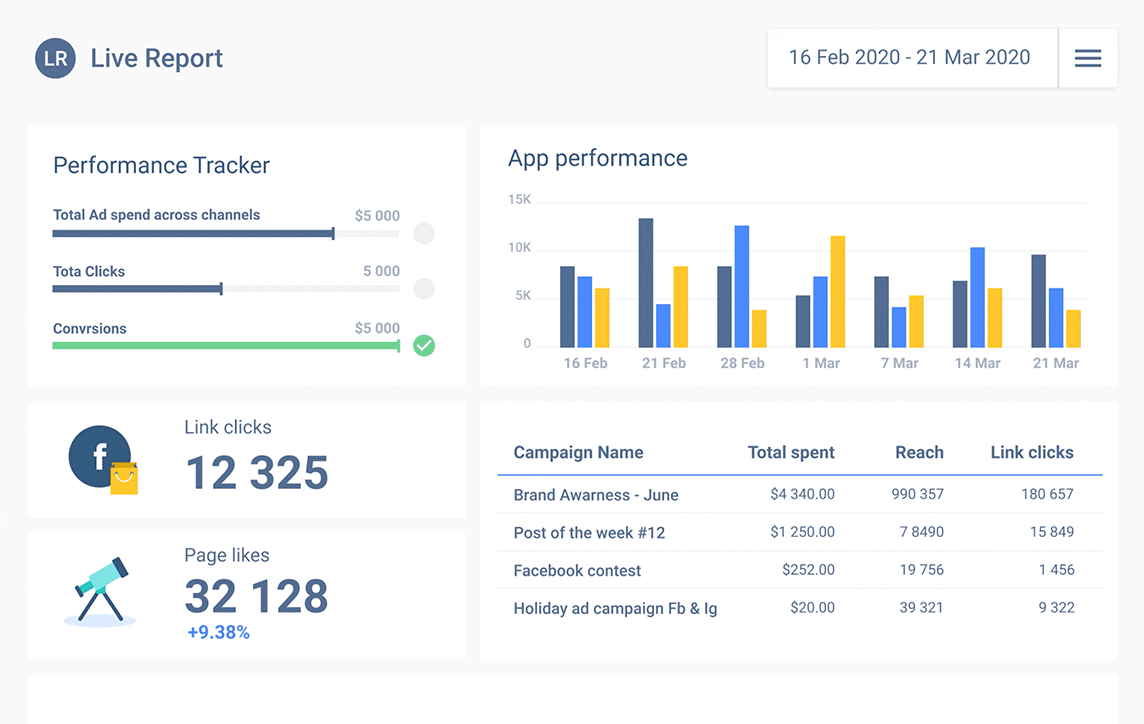What Are Management Reports and How to Create One
There are many different types of reports you can create and read in a business setting and not all of them hold the same weight. Management reports are one of the most important ones for decision-making as they have all the highlights and most important data for making business decisions.
With management reports, you don’t have to guess about where your company or business stands, or worry about the financial health of your business. They will help you make better, data-driven decisions that are crucial for the success of any business.

Apr 17 2020●5 min read

- What are management reports?
- What is the goal of using management reports?
- What should management reports include?
- 6 tips for creating amazing management reports
- A case for creating monthly management reports
- How to create a management report in 4 easy steps
- Create your first report in minutes instead of hours
What are management reports?
Management reports are the kind of marketing reports that provide data necessary for the company’s managers to successfully run the business. They present communication of business results, risks, and issues created by managers for executive management, managers, or governance bodies.
Management reports are of absolute importance for one organizational strategy, and every good leader knows it. They help them control and direct their businesses and make more informed decisions.
What is the goal of using management reports?
Data from different departments of the company is collected regarding relevant key performance indicators which are presented in a clear, easy-to-understand way. Usually, the way to do this is with elements such as bar charts, graphs, tables and other types of widgets. Writing a report is also an important part of the process.
Management reports disclose operational and financial information, thus helping managers to see the worth of their business over a specific period of time with smart financial reporting. They tell how the company is performing, providing the necessary information about different initiatives (such as cash flow and balance sheets) for the decision-makers to move in the right direction and increase operating efficiency.
Whatagraph offers you a way to simplify your management reporting with the many different marketing live reports available.
So, the goal of this type of reporting is to:
- Monitor and measure certain KPIs and performance metrics through internal reports;
- Understand the position and health of one business and suggest the next steps (e.g. through financial statements);
- Determine business intelligence benchmarks;
- Guide company manager’s next steps;
- Ensure better communication between executives, colleagues, and stakeholders;
- Help in the creation of action plans so the management can make better decisions;
- Track the company’s financial performance frequently;
- Foster continual business growth;
What should management reports include?
Here’s what to consider when creating a good management report:
- Strategic goals and objectives – start creating the report with the end in mind. Think about the reasons you need it, the key drivers of your business, your definition of success, and other data analysis questions.
Once you have the answers, you’ll know how to set the overall performance indicators to monitor different aspects of the performance. - The right KPIs – the KPIs you should include in your reports depending on your audience. Think about the data-driven questions the readers of the report would want to be answered, such as financial data. Remember, you should only include relevant information in your managerial reports.
- Customer feedback – take this into consideration when making your report, as customer feedback will help you see what you are doing right or wrong.
6 tips for creating amazing management reports
Reporting on insights from customer feedback surveys and product surveys helps in creating a more accurate, data-driven strategy and improving the overall business performance.
Tip 1: Use storytelling – connect the parts in your report with a few sentences explaining each section. Use the opportunity to tell a story about why certain metrics are low/high/not changing since the last report.
Tip 2: Make the report visually pleasing - give the most important spots on your report to key KPIs, and secondary or tertiary positions for other metrics. This will help people process your report more easily without getting overwhelmed.
Tip 3: Make the report clear, scannable, and drillable – ensure there’s plenty of white space in your report, contrasting colors, a data range presented next to the data, common metrics everyone can understand, etc.
Tip 4: Make the report visually balanced – present the most important KPIs in a concise way so that decision-makers can get the information without confusion.
Tip 5: Provide real-time insights in your report - make sure they align with your objectives for effective management reporting.
Tip 6: Keep on improving – test your reports regularly and make the necessary changes to ensure there are no inefficient or redundant data, i.e. duplication.
A case for creating monthly management reports
Organized and regular monthly management reports will ensure the strategy of your company stays on track. Here’s what they should include:
- A branded cover page – to make your report look more professional, make sure you include the logo or seal of your organization. You can do this easily with Whatagraph as there are different customization options to make your report look on-brand.
- Mission, vision, and values – these statements summarize your company’s strategy and reinforce its identity.
- Table of contents – include it in the beginning to make it easier for everyone to find what they are looking for. Especially for internal use, it makes it easier to find the right KPIs and initiatives quickly.
- Organizational scorecard views – include a thorough overview of your department or organization scorecard that would be organized in the order that it’ll be read.
- Detailed Pages – your monthly management report should have at least one detail page focused on each of your strategic goals or objectives.
- Charts – use them to present information on KPIs and discuss your measures. Make sure they are easy to read, have clear targets, and are consistent throughout the report.
- Project Overviews – your monthly report should only review the projects that drive your strategy instead of all projects.
- An online version – use a cloud-based software solution for your monthly management reports.
- A customized time-stamped footer – things you can include in the footer include the name of the report, confidentiality statements, and copyright information.
- A place to add action items – here’s where you capture major decisions from meetings.
How to create a management report in 4 easy steps
You may be thinking that these types of management reports are complicated and take a lot of time to prepare. No matter your business needs, you can create management reports and dashboards in minutes.
Step 1: Create a Whatagraph account. This data visualization and management reporting system takes just a few moments to sign up for.
Step 2: Start with a report template. You can find more than 100 different templates for reports in our library. This shortens your reporting processes and lets you find the best template for your use case in minutes.
Once you choose a template, it will be automatically populated with all the right widgets and metrics for that use case.
Step 3: Connect your data sources (Whatagraph has more than 40 of them available) and your data will populate in front of your eyes.
Step 4: Schedule your report so it gets sent out to the right people at your desired time interval. For example, you can set it up, so your manager gets it once per week or once every month.
Now sit back and relax. You’ve set the management report up once and it will arrive every week or month with fresh, accurate and up-to-date data in a visually pleasing form.
Create your first report in minutes instead of hours
No more Excel or Powerpoint - reporting tools such as Whatagraph are the future of creating management reports. Save time on reporting and impress your managers, all in one move.
Sign up for your free trial of Whatagraph and start creating amazing management reports today!

WRITTEN BY
Mile ZivkovicMile is the ex-Head of Content at Whatagraph. A marketing heavy with almost a decade of SaaS industry experience, Mile has managed multiple content marketing teams without losing an ounce of his writing passion.
